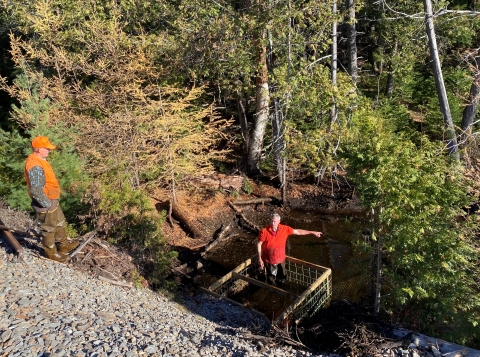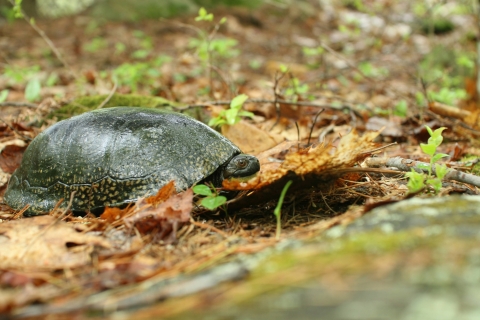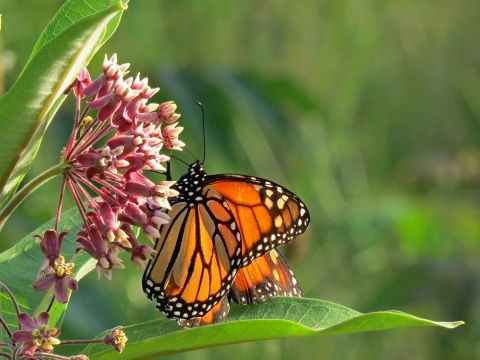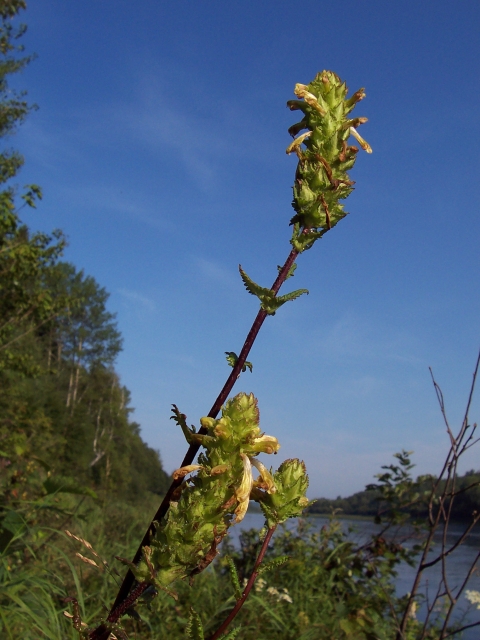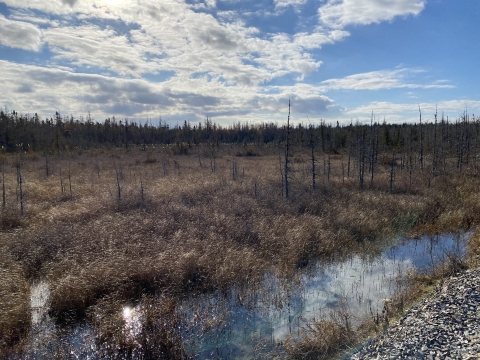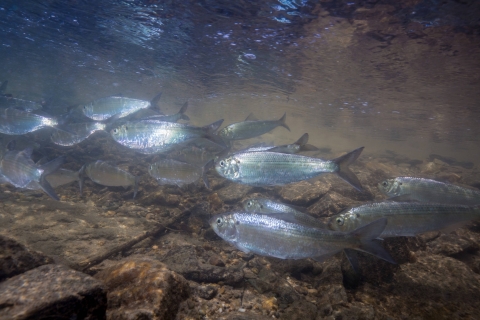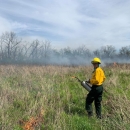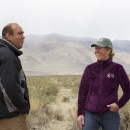Maine Partners for Fish and Wildlife Program
- Maine Partners Program Activities
- Focus Areas in Maine
- Who's eligible?
- What type of projects are funded?
- How does the program work?
- Public Outreach
The Service’s Partners for Fish and Wildlife Program provides technical advice, funding, and construction assistance to private landowners and Native American Tribes to restore and enhance fish and wildlife habitat on their property. Partners projects are focused on areas of conservation concern and federal trust species, including migratory birds, endangered, threatened, and at-risk species. All Partners projects are voluntary. Participating landowners retain all property rights and are not required to allow public access. Visit the national Partners for Fish and Wildlife Program Page for additional, general information on the program.
Maine Partners Program Activities
In Maine, over 200 landowners, including farmers and private conservation groups, have requested assistance from the Service’s Partners for Fish and Wildlife Program to restore habitat on private lands.
Many are leaving a legacy of stewardship for future generations by making the lands they own or manage a better place for fish and wildlife. Examples of the activities completed with the Maine Partners for Fish and Wildlife Program include:
- Grassland restoration
- Riparian restoration
- Forest stewardship
- Saltmarsh restoration
- Wetland management
- Freshwater stream restoration
- Farm Bill program technical assistance
Focus Areas in Maine
Focus areas in Maine are targeted geographical areas or species. If your project falls outside of these focus areas, you may still be able to receive assistance.
Northeast Turtles
Efforts in this focus area will be centered on conservation and restoration of habitat for state endangered Blanding’s turtle and box turtle, state threatened spotted turtle, and species of concern wood turtle. Small wetlands and vernal pools within large blocks of forested habitat are critical for these species. Adjacent upland habitat is also critical for nesting, basking, estivating, and for travel corridors between wetlands. Habitat loss and fragmentation from human development is a major threat to these species. Roads also bisect travel corridors and attract turtles to nest on gravel shoulders. In addition to turtles, this area includes one of the state’s largest Atlantic white cedar swamps, deer wintering areas, and inland waterfowl habitat. Activities in this area will include wetland and vernal pool conservation, turtle nesting habitat restoration, and riparian riparian
Definition of riparian habitat or riparian areas.
Learn more about riparian restoration.
Native Pollinators
The Native Pollinators Focus Area includes two geographical locations. The lowbush blueberry barren location is comprised of primarily conventionally managed lowbush blueberry fields. Native bumblebees are the primary target for conservation projects. Priority actions in this location are implementing integrated pest management to protect focus species from pesticide applications and establishing native vegetation to support pollinators throughout the year. The Acadian Plains location is concerned with grassland and hay land management for Monarchs, native bees, and grassland birds. Habitat improvement priorities for this location include restoring plant diversity in grasslands and implementing management strategies to limit destruction of focus species.
Upper St. John River
Work in this area is focused on the banks and adjacent riparian zones of the upper St. John River. This area is one of the most ecologically significant areas in Maine and supports several rare plant species. This location hosts the only known populations of the federally endangered Furbish’s lousewort. Common restoration efforts include riparian buffer plantings for bank stabilization and shade and invasive species invasive species
An invasive species is any plant or animal that has spread or been introduced into a new area where they are, or could, cause harm to the environment, economy, or human, animal, or plant health. Their unwelcome presence can destroy ecosystems and cost millions of dollars.
Learn more about invasive species removal.
Northeast Highlands
The Northeast Highlands Focus Area contains a high diversity of habitats with numerous rare species and natural communities. The focus area includes excellent examples of a lakeshore ecosystem and a mixed tall sedge fen natural community, the globally rare river-wash barrens community, pitch pine/scrub oak barrens, intact peatland systems, swamps and vernal pools, and the red maple fen natural community. The focal species is the small whorled pogonia, a federally threatened orchid that occurs in mixed-deciduous or mixed-deciduous/coniferous forest in second- or third-growth successional stages of at least 75 years old. Light availability could be a limiting factor for this species. Restoration efforts include low intensity overstory removal to reduce shading of the focal species.
Crystal Bog
The Crystal Bog Focus Area encompasses an extensive area of wetlands that is located in Aroostock County. The 1400-acre Crystal Bog is one of Maine’s best examples of a domed bog community. The large and diverse wetland complex represented by the focus area is one of Maine’s most diverse fens and includes a large number of rare plants and animals. Eastern prairie fringed orchid is the focus species for this area. Activities in this area will include prescribed burning in the dormant season, restoration of hydrology, and invasive species removal.
Diadromous Fish
Diadromous fish restoration is one of the highest priorities for the Service and the State of Maine. This focus area includes portions of the Penobscot and Sandy River watersheds. The Penobscot River watershed is New England’s second largest river, covering a third of Maine. The Sandy River has been identified by the State of Maine as the focus for Atlantic salmon restoration in the Kennebec River, the second largest watershed in Maine. The focal species is Atlantic salmon, which is federally endangered and requires aquatic connectivity to access high quality spawning and rearing habitat in the upper watersheds. Alewives will also benefit from projects in this area. Projects in this area will include restoration of riparian habitat, aquatic connectivity, and assistance with watershed restoration plans.
Maine North Woods
The November 2021 settlement agreement by USFWS to retain Canada lynx as a threatened species opens the door to new partnerships within Maine’s expansive North Woods region. This incredibly diverse region is not only home to Canada lynx, but also hosts pine marten, brook trout, wood turtles, and is a primary breeding area for neo-tropical birds. This relatively unbroken stretch of forest is a key stronghold for species whose habitats further south are impacted by development and climate change climate change
Climate change includes both global warming driven by human-induced emissions of greenhouse gases and the resulting large-scale shifts in weather patterns. Though there have been previous periods of climatic change, since the mid-20th century humans have had an unprecedented impact on Earth's climate system and caused change on a global scale.
Learn more about climate change .
Who's Eligible?
Technical assistance is available to all landowners in Maine. Financial assistance cannot be spent on federal or state lands but all other landowners qualify, including private landowners, tribes, county/city municipalities, corporations, businesses, private organizations, educational institutions, and conservation organizations.
What type of projects are funded?
Throughout Maine, cropland, pasture, wetland, upland, or stream habitats which have been previously drained or altered are all potential project sites. Partner projects are typically designed to restore fish and wildlife habitat to historic conditions. Plans may include:
- Removal of barriers to fish passage fish passage
Fish passage is the ability of fish or other aquatic species to move freely throughout their life to find food, reproduce, and complete their natural migration cycles. Millions of barriers to fish passage across the country are fragmenting habitat and leading to species declines. The U.S. Fish and Wildlife Service's National Fish Passage Program is working to reconnect watersheds to benefit both wildlife and people.
Learn more about fish passage , including culverts, dams, and other in-stream structures - Protecting and/or restoring riparian areas
- Constructing beaver exclosure devices to protect roads and wetlands
- Restoring grassland habitat for declining grassland birds and pollinator species
- Improving water quality in the federally endangered Atlantic salmon watersheds and rivers
How does the program work?
Maine landowners interested in habitat restoration should contact us to discuss potential opportunities and schedule a site visit. A MEFO biologist will work with you to determine if your site is suitable for restoration. If your property is identified as a beneficial project site, you could:
- Receive financial assistance to implement habitat enhancements/restoration
- Receive financial and/or technical assistance from other groups (state agencies, conservation districts, other Federal programs)
Financial or in-kind contribution from the landowner is not mandatory but will aid in project selection. Preference will be given to projects that leverage cost-share from the landowner and other potential partners. Most importantly, landowners do not forfeit property rights and they control all activities such as hunting, fishing, camping and land access.
Public Outreach
Partners Program staff are available to give webinars and lead discussions on conservation and restoration. We also work closely with public libraries, schools and scouting groups by leading field trips for youngsters interested in learning about wetland restoration and migratory birds. The Partners Program has been featured in Maine Public Radio broadcasts and on numerous local radio stations to help educate the public about the work of the Partners Program and the Service.
For additional information on the Maine Partners for Fish and Wildlife Program, please contact MEFO biologist, Hannah Mullally.

